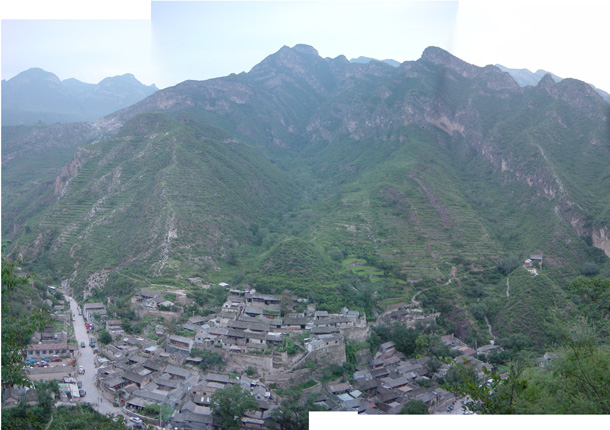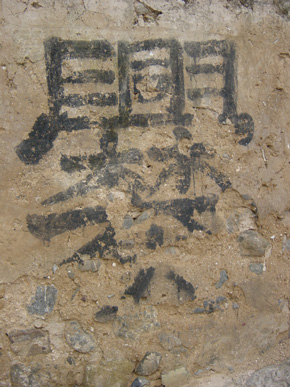
Weekend at Chuan Di Xia:
a Ming-era village nestled in Beijing's western hills
(Go to page 1,
2, 3, or 4)
Our new and wonderful friend Jane Liedtke, who founded and runs a great non-profit called "Our Chinese Daughters Foundation" (www.ocdf.org), first told us about Chuandixia when we asked her to recommend nearby, awesome, off-the-beaten track destinations. This historic village topped her list, so we were quick to sign up when she recently organized a weekend trip for her friends. We met the group at a local hotel and drove for about two hours through the famous "Western Hills" of Beijing, known for fragrant trees, cool breezes, and vacationing Party elite. After the obligatory bathroom stops (we had 10 adults and seven kids in the bus), we arrived at the tiny village, captured here in a multi-shot panoramic photo I took from a mountain across the way: |

| The village literally clings to the side of a mountain. The road at the base of the village was the main highway between Beijing and Xi'An (the ancient capital, site of Emperor Qin's tomb and the famous terra cotta soldiers ) back in the Ming dynasty, over 400 years ago. Today the village is still home to about 30 families, who raise corn. They have also recently begun opening their homes to tourists; a far-sighted local development official realized that making the site into a piece of living history would bring in badly-needed income while preserving the village's heritage - of a kind fast-disappearing in modern China. The plan has been so successful that in 1990, Chuandixia was declared the top-ranked historical village in all of China. This gave the residents, many of whom had left to work in Beijing, a big incentive to return and earn money by showing off their spectacular village to tourists. | |
Once
off the bus, we started our visit with a brief guided tour. |
|
Since the rendition on the wall was hard to read, we bought a copy from a local calligrapher who was quite happy to create a customized souvenir of our visit: |
|
 |
 |
| Naturally, such a large and complex character is going to have an interesting, powerful meaning: The top part means "prosperity", the middle part means "forest", and the lower part has a "big man" on top of a "fire" -- all in all an apt summary of the village. | |
| Next: we explore the village... | |